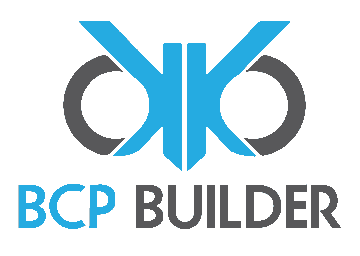BCP Builder
Business Continuity Planning
Visit BCP Builder to download a free example Business Continuity Plan.
Receive $100 off your subscription using the code FLOODEXPO (valid until 31 March 2020).
How to prepare for the unexpected
- When considering disasters that could disrupt your business it can be overwhelming because there are so many variations.
- When it comes to Business Continuity it is important to focus on the effect of any disruption rather than the cause. The goal is to effectively deal with any negative incidents that could impact your business.
What are the biggest threats a pandemic presents to your business?
- Loss of staff – staff who are sick or required to self-isolate will need to remain at home. You will need to consider if it is possible for them to work from home (if they are well enough).
- Loss of supply chain – You may no longer be able to procure essential items to your supply chain, or your suppliers could go out of business.
- Loss of customers – travel restrictions and risk-averse buying behavior could result in a significant downturn for your business.
Why do you need a Business Continuity Plan (BCP)?
There are many reasons that an organization should have a Business Continuity Plan. The pressure to produce a plan may come internally or externally from the organization:
- An external threat like Coronavirus
- Desire to improve Organizational Resilience – this request is likely to come from a Manager who sees gaps that need to be filled. These resilience gaps will be highlighted with a Business Continuity Plan and a process can begin to allocate the appropriate resources to the problem/s.
- Client request – more and more clients are being advised to check the resilience of their supply chain, which means that your larger clients may be asking you to produce a Business Continuity Plan.
- Audit – whether your organization is being audited or your clients (see above) it is highly likely you will be asked to produce your Business Continuity Plan.
When it comes to Business Continuity it is important to focus on the effect of any disruption rather than the cause. The goal is to effectively deal with any negative incidents that could impact your business.
How do I prepare a Business Continuity Plan?
There are two main options here; you can take a Do It Yourself approach or hire a Consultant.
If you choose to write your own plan, then it will be much easier if you find a Business Continuity Plan Template. This is because Business Continuity Management has its own ISO Standard – ISO 22301.
There are specific elements required to produce a comprehensive Business Continuity Plan and these are easily confused or overlooked. BCP Builder has developed a user-friendly template that allows you to quickly create a compliant Business Continuity Plan.
Plans and processes you should include in your BCP:
- People (skills and knowledge) – their safety should be your top priority.
- Infrastructure – could damage infrastructure restrict access to your premises?
- Premises (buildings and facilities) - is all maintenance up to date?
- Supply Chain (third party products and services) - do you have any single-source suppliers? This means you choose to use a single supplier, even though you could spread your risk by using more than one.
- Reputation - how much damage would an extended disruption cause to your reputation?
- Resources (IT, information, equipment, materials) - consider the age and maintenance of your resources.
- Finances (payroll and organizational funds) - do you have sufficient finances and cash reserves to carry you through a business disruption?
- Business Impact Analysis - list the Products, Services, and Activities undertaken by your organization in order of priority.
- Threat Analysis - are there any high-likelihood threats that are specific to your business or location?
- Incident Response Team - who would be the best people in your organization to respond to a crisis?
- IT Backup – Is your information backed up on OneDrive or something similar? Have you tested its availability?
- Fallback Site – do you have an alternative location to work from?
Case Study
One of my most recent clients was an ICT company that supplied services to Law Firms. These Law Firms asked to see their Business Continuity Plan and my client was concerned about how long it was going to take to produce.
My advice was that if they used BCP Builder’s template and sat down with the top management in their organization, they could produce a Business Continuity Plan within a week. They signed up, completed their plan, and forwarded it to their clients with a cover letter stating that their plan was compliant with ISO 22301.
Why businesses should be thinking about this
Having a robust Business Continuity Plan can be considered insurance for the uninsurable parts of your business. Things that you can’t insure against are market-share, customer confidence, and reputation.
How to come back after a business disruption
Having a plan in place means you will recover faster following a disruption because the event will have less impact on your business. If your business wasn’t badly impacted (particularly if others were), you will gain increased customer confidence.
Profile
Laura Toplis was the Business Continuity Coordinator for the New Zealand Ambulance Service and has developed a product from her experiences called BCP Builder – an Online Business Continuity Plan Template.
BCP Builder helps small and medium-sized businesses quickly design and build their own unique ISO22301-compliant business continuity plan, to be better prepared when disruption strikes to respond rapidly and recover confidently.


